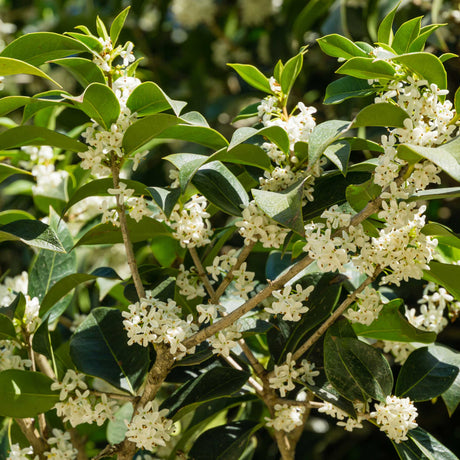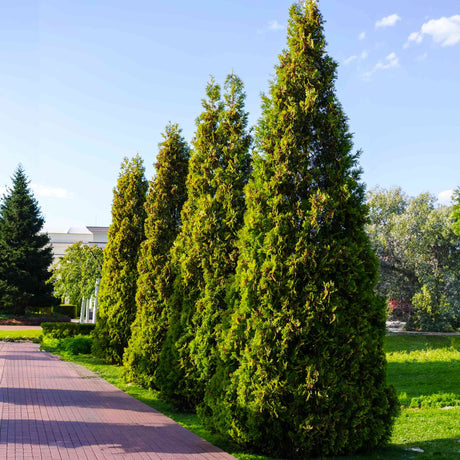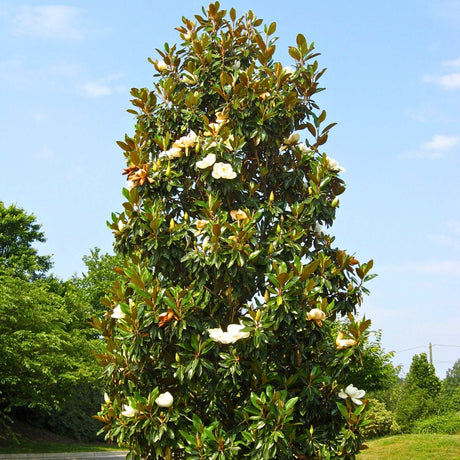- $11995
$19995Unit price /Unavailable - $11995
$27995Unit price /Unavailable - $12995Unit price /Unavailable
- $7995
$13995Unit price /Unavailable - $11995
$25995Unit price /Unavailable
Evergreen Trees: Year-Round Beauty and Functionality for Your Landscape
Evergreen trees are a versatile and essential addition to any garden or landscape, providing consistent color and texture throughout the year. Whether you’re looking to create a natural privacy screen, add structure to your yard, or simply enjoy the beauty of lush, green foliage in every season, evergreens are the perfect choice. These trees not only offer aesthetic appeal but also help shield your outdoor space from wind, noise, and prying eyes.
Why Choose Evergreen Trees?
Year-Round Greenery
Unlike deciduous trees that shed their leaves in the fall, evergreens maintain their vibrant foliage all year long. This makes them a fantastic option for creating visual interest in your landscape even during the colder months. The consistent color and texture of evergreens bring structure and beauty to your yard, no matter the season.
Privacy and Windbreaks
Many evergreen varieties are fast-growing, making them ideal for creating privacy screens or windbreaks. Their dense foliage provides a natural barrier to block out unwanted views and noise, while also helping to reduce wind and protect more delicate plants in your garden.
Low-Maintenance and Hardy
Evergreens are generally low-maintenance and adaptable to a variety of climates and soil conditions. Whether you're planting in a large yard or a small garden, there’s an evergreen to suit your needs. Their hardiness and drought tolerance make them a reliable, long-lasting choice for homeowners and landscapers alike.
Popular Evergreen Varieties for Your Garden
Thuja Green Giant
- Botanical Name: Thuja standishii x plicata
- Mature Height: 20-40 ft.
- Why Choose It: This fast-growing evergreen is perfect for creating privacy screens or windbreaks. With its tall, dense growth, the Thuja Green Giant provides excellent coverage and is resistant to deer, making it a popular choice for large landscapes.
Leyland Cypress
- Botanical Name: Cupressocyparis leylandii
- Mature Height: 30-50 ft.
- Why Choose It: Known for its rapid growth, the Leyland Cypress is another top choice for privacy. Its soft, feathery foliage forms a dense screen, making it ideal for homeowners looking to block out noise or neighbors quickly.
Emerald Green Arborvitae
- Botanical Name: Thuja occidentalis ‘Emerald Green’
- Mature Height: 8-12 ft.
- Why Choose It: For those with smaller yards, the compact Emerald Green Arborvitae offers a neat, uniform shape that's perfect for hedges or as a vertical accent. Its bright green foliage stays vibrant throughout the year.
Italian Cypress
- Botanical Name: Cupressus sempervirens
- Mature Height: 30-40 ft.
- Why Choose It: If you're looking for a tall, columnar tree that adds an elegant Mediterranean feel to your landscape, the Italian Cypress is the perfect choice. Its narrow shape makes it ideal for framing entrances or lining driveways.
Spartan Juniper
- Botanical Name: Juniperus chinensis 'Spartan'
- Mature Height: 15-20 ft.
- Why Choose It: The Spartan Juniper is a versatile evergreen with dense, dark green foliage. It's excellent for use as a privacy screen, windbreak, or even a standalone accent in your garden. Its tough, adaptable nature makes it a low-maintenance favorite.
More Evergreen Varieties to Explore
Moonglow Juniper
- Botanical Name: Juniperus scopulorum 'Moonglow'
- Mature Height: 15-20 ft.
- Why Choose It: Known for its striking silvery-blue foliage, the Moonglow Juniper adds unique color and texture to any landscape. Its dense, pyramidal form makes it perfect for use as a privacy screen or as a focal point in the garden.
Taylor Juniper
- Botanical Name: Juniperus virginiana 'Taylor'
- Mature Height: 15-20 ft.
- Why Choose It: With its slim, upright form, the Taylor Juniper is ideal for tight spaces where height is needed but width is limited. It's a great choice for lining walkways or creating privacy in narrow areas.
Arizona Cypress - Carolina Sapphire
- Botanical Name: Cupressus arizonica var. glabra
- Mature Height: 30-50 ft.
- Why Choose It: The Carolina Sapphire Arizona Cypress is loved for its blue-gray foliage and pleasant fragrance. This fast-growing tree is drought-tolerant and makes a beautiful windbreak or privacy screen in hot, dry climates.
Hollywood Juniper
- Botanical Name: Juniperus chinensis 'Kaizuka'
- Mature Height: 15-25 ft.
- Why Choose It: With its dramatic, twisted branches, the Hollywood Juniper adds architectural interest to your landscape. Its unique form and dense foliage make it a standout choice for adding texture and height to your garden.
American Pillar Thuja
- Botanical Name: Thuja occidentalis 'American Pillar'
- Mature Height: 25-30 ft.
- Why Choose It: This fast-growing, narrow tree is ideal for creating a tall privacy hedge in tight spaces. Its dense, upright form provides excellent coverage without taking up too much room in your yard.
Factors to Consider When Choosing Evergreen Trees
Growth Rate
Evergreens like the Thuja Green Giant and Leyland Cypress are known for their fast growth, making them perfect for homeowners looking to establish privacy quickly. Slower-growing varieties like the Emerald Green Arborvitae are better suited for smaller spaces or more controlled growth.
Climate and Hardiness
Evergreens are generally adaptable, but some varieties thrive better in specific climates. For example, the Arizona Cypress and Italian Cypress are well-suited for hot, dry climates, while the Spartan Juniper and Emerald Green Arborvitae perform well in a range of temperatures.
Size and Shape
From tall, narrow trees like the Taylor Juniper and Italian Cypress, to more compact varieties like the Emerald Green Arborvitae, evergreen trees come in many shapes and sizes. Consider the space you have available and choose a variety that fits your landscape's dimensions and design needs.
Planting and Caring for Evergreen Trees
Planting Tips
When planting evergreens, choose a sunny spot with well-draining soil. Dig a hole twice as wide as the root ball, but only as deep as the tree was growing in its nursery pot. Place the tree in the hole and backfill with soil, making sure to water thoroughly after planting to help the roots establish.
Watering and Fertilization
Evergreens need regular watering, especially during their first year of growth. Once established, they are generally drought-tolerant but will benefit from deep watering during dry periods. Apply a slow-release fertilizer in early spring to encourage healthy growth.
Pruning and Maintenance
Pruning is generally minimal for most evergreen trees but can be done to shape the tree or remove dead or damaged branches. Late winter or early spring is the best time for pruning. Be sure to mulch around the base of the tree to retain moisture and protect the roots.
FAQs
1. How fast do evergreen trees grow?
Growth rates vary by species. Trees like the Thuja Green Giant and Leyland Cypress can grow 3-5 feet per year, making them great for quick privacy screens. Slower-growing varieties, like the Emerald Green Arborvitae, grow about 6-12 inches per year.
2. How far apart should I plant evergreens for a privacy screen?
The spacing depends on the tree variety and its mature width. For example, the Thuja Green Giant should be planted about 5-6 feet apart, while narrower varieties like the Taylor Juniper can be spaced closer together, about 3-4 feet apart.
3. What is the best time of year to plant evergreen trees?
The best time to plant evergreen trees is in the fall or early spring. This allows the trees to establish their root systems before the heat of summer or the cold of winter sets in.
4. Can I grow evergreens in containers?
Yes, many evergreen varieties, such as the Emerald Green Arborvitae and Spartan Juniper, can be grown in containers. Be sure to use a large container with good drainage and water regularly, as container-grown evergreens can dry out more quickly than those planted in the ground.
5. Do evergreens need to be fertilized regularly?
Evergreens benefit from annual fertilization, especially in early spring. Use a slow-release fertilizer formulated for evergreen trees to promote healthy growth and vibrant foliage. Avoid over-fertilizing, as this can lead to excessive, weak growth.
6. Can I plant evergreens in full sun?
Yes, most evergreen trees thrive in full sun, needing at least 6 hours of direct sunlight each day. However, some varieties, like the Moonglow Juniper, can tolerate partial shade. Always check the specific sunlight requirements of the evergreen variety you're planting.
7. How do I prevent browning of evergreen foliage?
Browning of evergreen foliage, also known as winter burn, can occur due to harsh winter conditions or drought stress. To prevent this, water deeply in the fall before the ground freezes, mulch around the base of the tree to retain moisture, and protect young trees from strong winter winds by using burlap wraps or windbreaks.
8. Can evergreens handle poor soil conditions?
Evergreens are generally adaptable to various soil types, but they prefer well-draining soil. If your soil is heavy clay or tends to retain water, consider amending it with organic matter or planting in raised beds to improve drainage.
9. How tall will my evergreen tree grow?
The mature height of your evergreen tree depends on the variety. For example, Thuja Green Giants can reach up to 40 feet tall, while more compact varieties like the Emerald Green Arborvitae typically max out around 12 feet. The mature height will also depend on how closely you plant the evergreens. Planting your evergreens more closely can limit their growth if that is your goal. Always check the expected mature height of the specific variety you choose to ensure it fits your landscape.

































